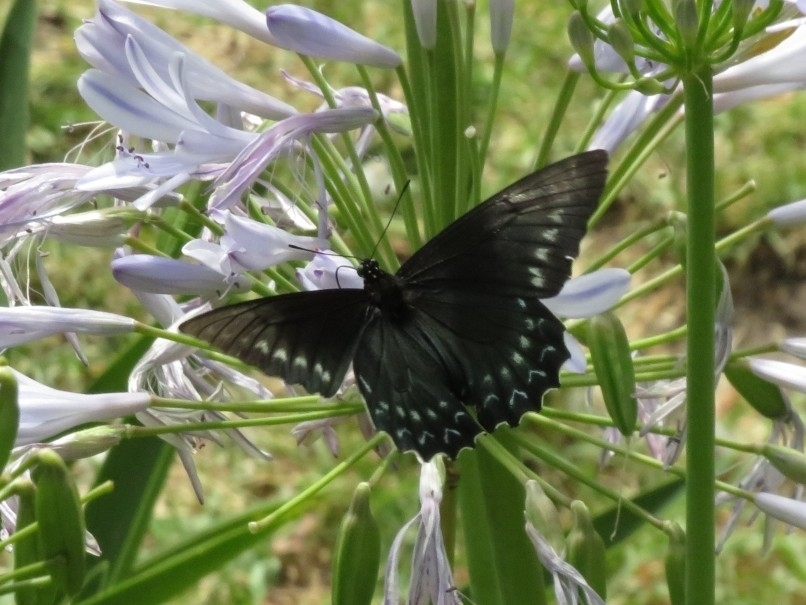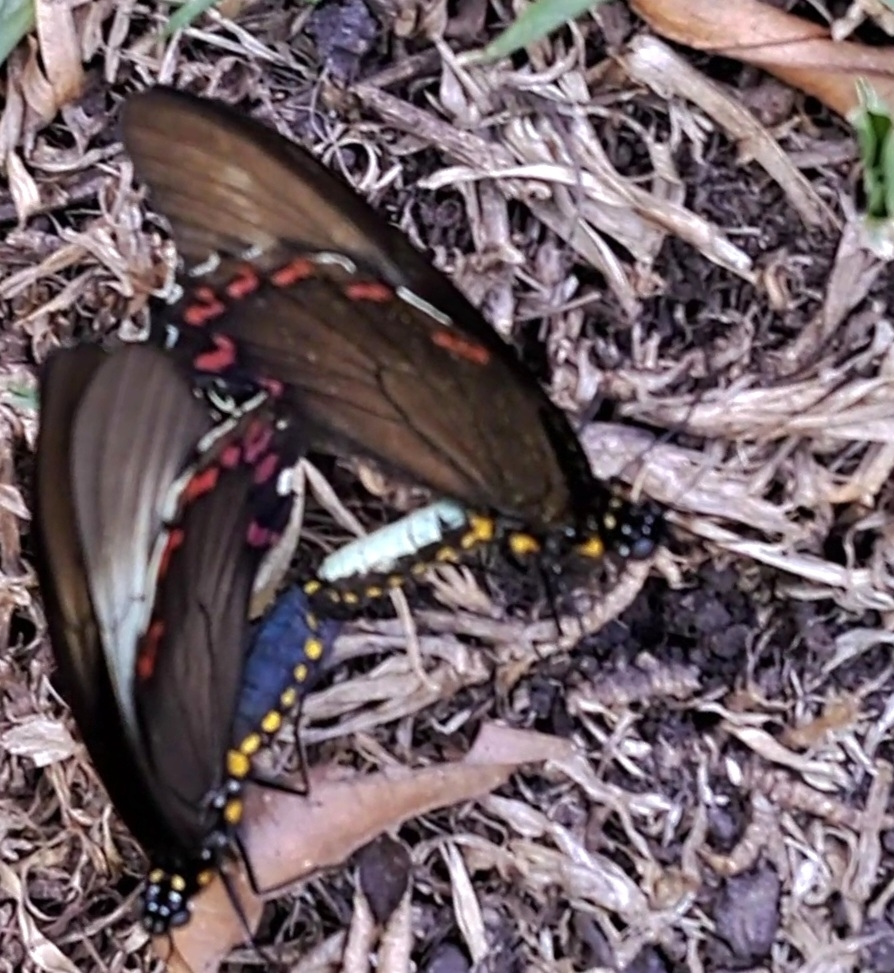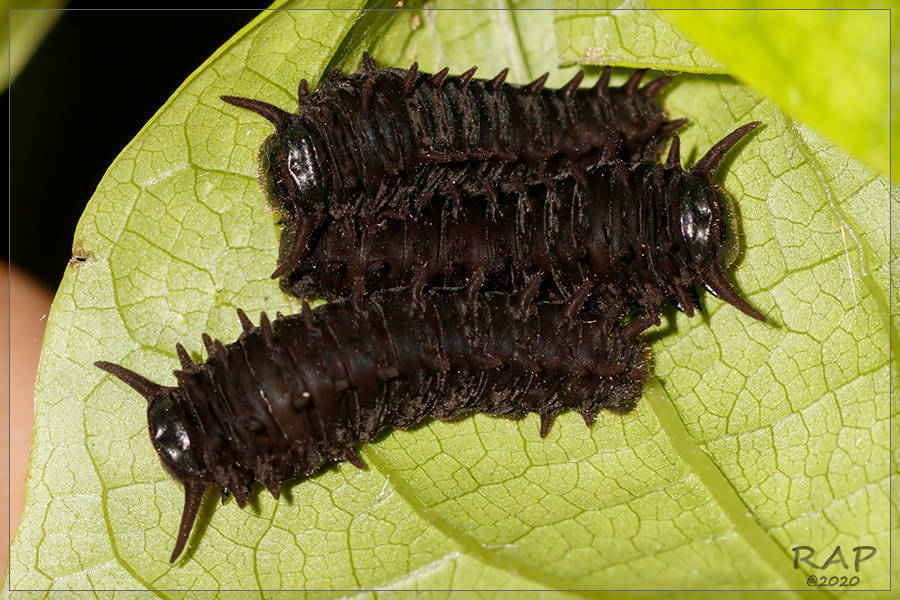This week's butterfly looks a bit like last week's, only less colorful. Its black wings can have a lovely iridescent greenish sheen in some lights, so it's known in its native lands as Mariposa borde de jade when it's not merely called Polysticto. In English, Battus polystictus is the Jade-Bordered Butterfly--or Swallowtail, from its wing structure, although it does not actually have the "swallowtails."
Why Polystictus? It was traditional to name Swallowtail species after heroes of ancient literature, but if there was a character called Polystictus, he wasn't much of a hero. All Google shows for this name is that it's the scientific name of a kind of fungus and a kind of bird. The scientist who first describes a new species gets to name it and is not required to explain the name. In Greek poly means "many" and stiktos means "spotted, or pricked." Many other butterflies are spottier than Battus polystictus but Professor Butler, who named polystictus, did not have the right to name the other species.
A fun fact about butterflies generally is that their wings have no color.
"Say WHAT? Even if you're saying black is not a color, what about the yellow, blue, and orange..."
Butterflies are very colorful animals but the colors are not precisely in the wings. They are in the tiny velvety (sometimes furry) scales that cover the wings and body of the butterfly. If you were cruel enough to rub the "powder" of scales off part of a butterfly's wing, the wing itself would be as transparent as a housefly's wing. (And the butterfly might survive--they often manage to fly even with parts of the wings themselves torn away--but it wouldn't fly as well or live as long. Telling children that damaging )the wings will kill a butterfly is like telling them that if they cross a crowded street or parking lot alone they will be run over by cars. Parents who value truthfulness should say "could.")
In September 2022, in Brazil, Rodrigo Lazaro found the right angle to show where the Jade-Bordered Butterfly got its name.
And the scales that cover butterflies and moths, making them the Lepidoptera or "scale-winged" insects, get their color from the way their shapes reflect light. Dark-colored butterfly wings are especially hard to classify. Their base color seems to be black, or blackish brown or blackish gray, but depending on the light they can almost glow in shades of blue or green. So, sometimes you can see the Jade-Bordered Butterfly's jade border, and sometimes you can't. Bright warning colors come from chemicals, usually toxic chemicals, in the plants the caterpillars eat...and the amount of them retained in the body can vary. Battus polystictus displays less vivid warnings than some other Battus and may in fact be less toxic. It's still nasty enough that eating it is not considered trendy or edgy or even punk for humans.
It lives in Argentina, Brazil, Paraguay, and Uruguay, and sometimes Chile. Much of what's been written about it has been in Spanish or Portuguese. Scientific writing is usually easy to translate, however, even without translation software.
In some places these butterflies are active all year. In places that have distinct summer and winter seasons they're less active in winter. They fly for three weeks or more, and age groups overlap. Unlike some Battus species, such as philenor, where the largest generational group pupate in winter and eclose (energe from pupation) in spring, polystictus populations seem consistent throughout as much of the year as the butterflies are active. They don't show a seasonal migration pattern, and don't fly far; one study that tracked individual butterflies suggested that most individuals fly less than one kilometer in their lifetimes.
Males and females look more alike in this species than in many Swallowtail species. Females have black bodies. A yellow or white stripe covering most or all of the upper surface of the abdominal segments is believed to identify male butterflies, though, if reliable, this means that males may outnumber females by10 to 1..(Many Swallowtail species have a female type that looks different from the male, and a female type that looks more like the male.) Females' wings are slightly bigger than males', but the size difference is not great enough or reliable enough for easy identification of living butterflies. Size differences are also influenced by weather conditions; butterflies who pupated in winter are smaller than those who pupated in warm weather. The rest of the body and wings are dark, with borders of yellow or cream-colored spots above, some red and blue below. The wingspread is 8 to 9 centimeters, between three and four inches.
Butterflies seem to recognize one another by scent, and conform to gender expectations. Males stake out territories where they can display themselves in the sun. Females spend most of their time in the forest, looking for vines on which to lay eggs. Neither sex normally wastes much energy on flying very far. Females visit males' territories; males chase other males off their territories by flying at them, and show interest in females by flying in circles around them. The preferred food plant for caterpillars seems to be Aristolochia triangularis, which climbs high up trees, and the female butterflies spend much of their time selecting fresh, juicy new stems and leaves on which to lay eggs. Any number of eggs from one to eighteen may be laid in the same place.
Photo by Maria_4, from rural Brazil, showing this species' tendency to mate side to side and avoid wing contact. They are not among the few large butterfly and moth species that cuddle. Male Swallowtails usually show more blue iridescence, but females can look blue or green in the right light too. Or, like the two above, their black wing scales can even reflect light and look white.
They are pollinators, and usually fly high, on the level of the flowers they pollinate and the leaves they ate as caterpillars. Their favorite flower appears to be Lantana. They pollinate several flower species.
In addition to the main or "nominate" subspecies, there is one more subspecies, B.p. galenus, found around the Rio de Janeiro. Galenus have more conspicuous spots. Individuals are not always easy to classify, but this one seems clearly to belong in the galenus category.
Some sources list a subspecies janira, but this seems to be outdated usage; little information about janira is available. Rothschild accepted janira as a distinct subspecies but even Funet now lumps it together with galenus.
Because these butterflies, though fairly common, keep out of humans' way, one would expect them to have been less studied than some other Battus. They are, but they have appeared in a few papers, like this solemnly funded amd published, speculative bunkum about how they'd be likely to cope with one of the ever-changing theoretical models of "global climate change."
Let's just say that they are endangered by the habitat loss, including local warming, that occurs when humans pack into cities and mow and spray and drive motor vehicles everywhere and run electric heat pumps all year. Whether the local warming effect is sufficient to harm the butterflies, or whether they starve out first due to destruction of their food plants, urbanization and habitat loss is something we want to prevent. Some places have taken steps to protect Battus polystictus.
Eggs, like wing spots, may be paler-colored than other Battus:
Caterpillars hatch and feed at least ten feet above the ground, so humans seldom have to look at them. Like the other Troidini (butterflies in the Swallowtail family that eat Aristolochia vines), they seem to try to look like something a bird already ate and regretted eating. Most predators do regret eating anything whose primary food plant is Aristolochia. The caterpillars can't be blamed for false advertising.
Young caterpillars may benefit from the camouflage they get by lining up side by side. Several species of moth and butterfly caterpillars seem to like to feel a sibling's side against their side while they nibble on a leaf. This behavior lasts until the animals grow big enough that each one wants a leaf of its own.
It hardly needs to be mentioned that, like nearly all caterpillars, they're harmless unless and until they are swallowed. Caterpillars' little claws tickle our skin in what most humans agree is an annoying way, and their short hairs can be about as itchy as short ends of our own hair (which can also raise hives if they get under our collars in hot weather). Only a small minority of caterpillars have venomous bristles, and none of those species are Swallowtails. The little knobs and horns on caterpillars n the tribe Troidini are soft to the touch, properly described as tubercles or warts. They are covered in a tough indigestible skin material called chitin. Nevertheless, it's a survival advantage for caterpillars generally that larger animals think they look nasty.
This older caterpillar was also photographed by R_A_P. The "humpbacked" shape of many young Swallowtail caterpillars smooths out as they mature, but the thoracic segments remain thicker than the head and neck, partly because they contain osmeteria. The osmeterium is a forked bit of erectile tissue that exudes a species-specific odor that predators seem to disike. It looks a bit like the forked tongue of a tiny snake, which probably helps scare off birds.
While "making caterpillars put out their horns" seems harmless, as studies of Battus polydamas showed last week, it may stress the caterpillars enough to affect their growth. But they can't be blamed for not giving other animals fair warning. Eating a baby Battus is a very bad idea.
The pupal skin, or chrysalis, looks like a dying or dead leaf. It's amusing to watch this limbless, apparently lifeless, object squirm its way out of a caterpillar's skin.
This short video tries to captuure the miracle of eclosion. What people don't understand is that it takes a winged insect a few hours to unpack wings, long legs, and an adult body, all at once, from a smaller shell. It takes great patience to observe and document the process. Even though you can see the animal stretch and expand in little jolts, it expands by millimeters and some of those jolts of expansion take place inside the body. Meanwhile less lovable insects have probably found you, and you don't want to stress your little friend by slapping at them or refreshing your mosquito repellent, and every time you pick a mosquito off your arm you remember a few hundred other things you want to do. A few years ago when I had a chance to watch a cicada eclose, I reminded myself that the cicada was undoubtedly more vulnerable, and very likely more eager to get on with its life, than I was, and I'd been responsible for predators having seen it and gathered to watch it. Professional biologists aren't usually paid to spend time with individual butterflies that way.
Fortunately, butterflies can eclose without human observation. They don't seem capable of understanding anything about what humans are, or why, but although polystictus prefer to live at a higher altitude and mostly ignore humans, occasionally they alight on a human arm. Lantana flowers are sometimes said to smell like sweaty socks; butterflies who live on these flowers' nectar probably sense that they can get some of the same mineral salts by licking human skin. So although they can get along quite well without ever seeing humans, they occasionally approach humans in a friendly, even doglike way.












No comments:
Post a Comment